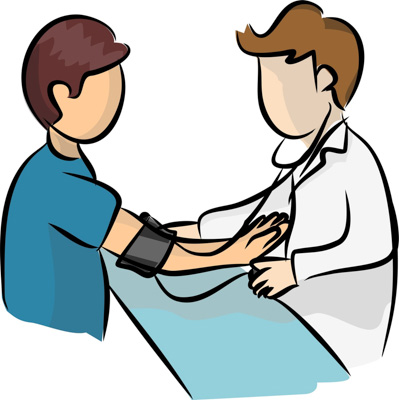Cases Related To Blood Pressure - Part I

Using this course
Each lesson in this course includes text describing the heart or lung abnormality and a simulated torso indicating the stethoscope chestpiece location. An audio recording of the sound is provided. Phonocardiograms or waveforms are included with each lesson. These waveforms can be a highly useful aid in learning to recognize heart murmurs. In addition, short videos clips illustrate the heart's motion for each abnormality. These animations indicate the origin of each murmur. Blood flow is also animated. For lung sounds, the source (location) of the sound can be revealed.
After completing a lesson, use the lesson table of contents to navigate to another lesson.
When all lessons have been completed, we recommend using the auscultation practice exercises or quiz. In order to gain a certificate of achievement, please complete the course lessons and practice drill during one session. Most users complete the course's lessons and drills in 30-45 minutes.
Lessons
Lesson #1: 40-year-old man with headaches and shortness of breath
A 40-year-old man complains of headaches and three episodes of nosebleed over the last month.
Lesson #2: 45-year-old woman with headache and facial swelling
45-year-old woman presents with a one-month history of headache and facial swelling (moon facies).
Lesson #3: A 50-year-old man with weight loss, fatigue, weakness...
A 50-year-old man is seen by his doctor for unintentional weight loss, fatigue, and extreme weakness. Doctor notes darkening of the skin.
Lesson #4: A 65-year-old woman with a two-hour history of chest pain and dizziness.
A 65-year-old woman arrives at emergency room with a two-hour history of chest pain and dizziness.
Lesson #5: A 54-year-old man is brought to the emergency room from his doctor's office.
A 54-year-old man is brought to the emergency room from his doctor's office. Chief complaint is sudden onset of severe chest discomfort. Discomfort had a tearing nature.
Lesson #6: A 45-year-old man complains of shortness of breath with exertion.
A 45-year-old man complains of shortness of breath with exertion.
Lesson #7: Ten-year-old girl brought to office by mother.
Ten-year-old girl brought to office by mother. Mother states patient has had nosebleeds over the past three months. Also complains of pounding headaches, dizziness and exercise induced leg cramps.
Lesson #8: A 60-year-old woman enters emergency room after a recent fainting episode.
A 60-year-old woman enters emergency room after a recent fainting episode following a strenuous hike. The patients medications include a diuretic for high blood pressure. Diuretic dose was recently increased from 25 to 50 mg per day.
Lesson #9: A 45-year-old woman complains of a two-month history of fast heart rate and palpitations.
A 45-year-old woman comes into your office complaining of a two-month history of fast heart rate and palpitations. She also notes sweating and nervousness. In addition, she complains of a swelling in the lower portion of her neck. Examination reveals a diffuse goiter.
Lesson #10: A 75-year-old woman complains of lethargy ...
A 75-year-old woman is seen in her physician's office with a chief complaint of a two-month history of lethargy, swelling in lower portion of her neck (goiter) and coarse skin.
Authors and Reviewers
-
Heart sounds by Dr. Jonathan Keroes, MD and David Lieberman, Developer, Virtual Cardiac Patient.
-
Heart sounds mentorship: W. Proctor Harvey, MD
- Reviewed by Dr. Barbara Erickson, PhD, RN, CCRN.
-
Last Update: 12/9/2022
Sources
-
Heart Sounds and Murmurs Across the Lifespan (with CD)
Dr Barbara Ann Erickson
Publisher: Mosby
ISBN-10: 0323020453; ISBN-13: 978-0323020459 -
Heart Sounds and Murmurs: A Practical Guide with Audio CD-ROM 3rd Edition
Elsevier-Health Sciences Division
Barbara A. Erickson, PhD, RN, CCRN - How to measure blood pressure using a manual monitor
Mayo Foundation for Medical Education and Research (MFMER) - Manual Blood Pressure Measurement
Vital Sign Measurement Across the Lifespan